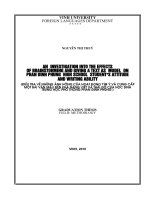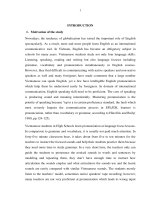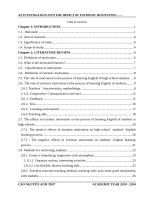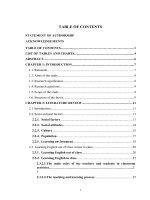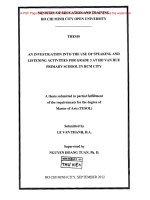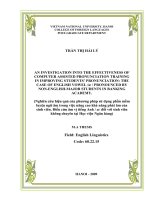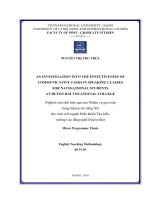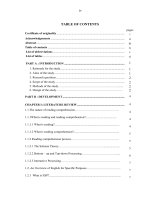An investigation into the effects of brainstorming and giving a text as model on phan dinh phung high school student's attitude and writing ability
Bạn đang xem bản rút gọn của tài liệu. Xem và tải ngay bản đầy đủ của tài liệu tại đây (396.53 KB, 60 trang )
Vinh university
Foreign languages department
Ngun ThÞ Th
An investigation into the effects
of brainstorming and giving a text as model on
phan dinh phung high school students attitude
and writing ability
(Điều tra về những ảnh hëng cđa HOẠT ĐỘNG TÌM Ý vµ cung cÊp
mét bµi văn mẫu đến khả năng viết và thái độ của học sinh
trung học phổ thông Phan đình phùng )
Graduation thesis
Field: methodlogy
Vinh, 2010
Vinh university
Foreign languages department
------------------------
An investigation into the effects of brainstorming and
giving a text as model on phan dinh phung high school
students attitude and writing ability
(Điều tra về những ảnh hởng của HOT NG TèM í và cung cấp
một bài văn mẫu đến khả năng viết và thái độ của học sinh
trung học phổ thông Phan đình phùng )
Graduation thesis
Field: methodlogy
Supervisor: Vũ Thị Việt Hơng, M.A
Student:
Nguyễn Thị Thuý
Class:
46 E1- English
Vinh, 2010
Acknowledgements
For this completion of this work. I have received invaluable contributions
from many people.
First of all, I would like to express my special words of thanks to Vũ Thị
Việt Hơng, M.A, of Vinh University of Foreign Language Department, my
supervisor for her valuable corrections during the reading of this work in
manucript without which the work would not have been completed.
I own a special debt of gratitude to Ngun Thị V©n Lam, M. A who
provides the knowledge of reseach for me.
In addition, I should also like to extend my deep thanks to all my teachers
in the Department of Foreign Language for their endless enthusiasm and
undeniably useful lectures.
I also repeat my thanks to the students who have participated in classes
reported in this thesis as well as teachers of Phan Dinh Phung high school. If
with out their cooperation the study will be far from perfect.
My warmest thanks to my loving parents and my close friends for their
uncondition love,encouragements and the support about finance to my doing
this thesis.
Finally, I hope that my reseach will become useful for readers who want
to become a good teacher of English.
Vinh, May 2010
Ngun ThÞ Thóy
List of Abbreviation
EFL: English as a foreign language
ESL: English as a second language
ELT: English language teaching
e.g : For example
LIST OF TABLES AND CHARTS
Table 1: The detail of the subject assignment.
Table 2: The steps of a writing lesson of control group.
Chart 1: The experimental group’s general feelings about brainstorming.
Chart 2: The experimental group’s general feelings about the cooperation in
Brainstorming.
Chart 3: The experimental group’s opinion about the effects of brainstorming.
Chart 4: The experimental group’ view on the use of brainstorming.
Table 8: The reasons of approval of the application of brainstorming in the future.
Table 9: The reasons for disapproval of application of brainstorming in the future.
Chart 5: The control’s group feelings about giving a text as a model.
Chart 6: The control’s group feelings about reading a text as a model
Individually.
Chart 7: The control group’s opinions about the effects of giving a text as a model.
Chart 8: The control group’s views on the use on the use of giving a text as a model.
Tables 10: The reasons for the approval the application of giving a text as a
model in the future.
Table 11: The reasons for the disapproval of application of giving a text as a
model in the future.
TABLE OF CONTENTS
Page
ACKNOWLEDEGEMENT……………………………………………. i
LIST OF ABBVIATION……………………………………………….. ii
LIST OF TABLES AND CHARTS …………………………………... iii
TABLE OF CONTENTS………………………………………………. iv
ABSTRACT ……………………………………………………………. vi
PART I:
INTRODUCTION…………………………………... 1
1.1 Rationale of the Study ………………………………………………. 1
2
1.2 Aims of the Study …………………………………………………
1.3 Scope of the study ………………………………………………….. 2
1.4 Methods of the Study ……………………………………………….. 3
1.5 Design of the sSudy ………………………………………………… 3
PART II:
CONTENT………………………………………. 5
CHAPTER I: THEORICAL BACKGROUND…………………………
5
1.1
Overview of Writing ………………………………………….. 5
1.1.1
Writing ………………………………………........................... 5
1.1.2
What Makes an Affective Piece of Writing …………………… 6
1.1.3
The Component of Skilled Writing Ability…………………… 7
1.1.4
Factors Affecting Student’s Writing Ability ………………… 8
1.1.4.1 Psychological difficulties……………………………………… 8
1.1.4.2 Linguistic difficulties………………………………………….. 8
1.1.4.3 Cognitive difficulties…………………………………………... 9
1.1.5
Improving Student’s Writing Ability ………………………… 9
1.2
Teaching Writing in Language Classroom ……………………
1.3
Overview of Pre-writing Activities …………………………….
1.3.1
Importance of Prewriting Activities …………………………
1.3.2
Types of Prewriting…………………………………………….
1.3.2.1 Clustering and Mindmaps……………………………………
1.3.2.2 Free writing…………………………………………………….
1.3.2.3 Journal writing…………………………………………………
1.3.2.4 Giving a short text as a model …………………………………
1.3.2.5 Brainstorming …………………………………………………
1.4.
Attitude………………………………………………………..
1.5.
Summary………………………………………………………
CHAPTER 2: THE STUDY………………………………………………
2.1
Real Situation……………………..………………………………
2.2
Subject and Subject Assignment…………………………………..
2.2.1 Subject……………………………………………………………..
2.2.2 Subject Assignment……………………………………………….
2.3
Describe Questionnaires ………………………………………….
2.4
Procedures of the Study…………………………………………
CHAPTER 3: RESULTS AND DISCUSSIONS …………………………
3.1
Results of student questionnaire…………………………………..
3.1.1 Questionaire 1 …………………………………………………..
3.1.2 Questionnaire 2…………………………………………………..
3.2 Summary of findings ………………………………………………
PART III : CONCLUSION ……………………………………………
1. Recapitulation of the Study…………………………………………….
2. Suggestions for Teaching Prewriting Activities at Phan Dinh Phung
high school………………………………………………………………..
3. Implications of the Atudy……………………………………………..
4. Suggestions for further Study………………………………………….
REFERENCES………………………………………………………….
APPENDIX…………………………………………………………….
10
11
11
12
12
13
13
13
15
17
19
20
20
20
20
20
21
23
25
25
25
31
37
39
39
39
41
41
43
ABSTRACT
This study investigated the different effects of brainstorming and giving a
text as a model. In this study, these were called 2 types of prewriting activities.
The experiment lasted 8 weeks. In one class, the control group, the
teacher applied giving a text as a model for teaching prewriting stage. She
presented the model to student’ reading first, then discussed and analyzed the
model to increase students generate their own parallel essays on a suggested
topic.
In the other groups, the teacher carried out brainstorming at prewriting
stage. Teacher stated the topic and wrote it on the black board and then gave any
explanations that might be needed. Students worked from a student group to
whole group. The topic to brainstorm could also come from a single student or
a student group. Then students generated ideas by asking their own suggestions
usually by collaborating with the people around them or following teacher’s
suggested criteria. Next, they cleared up ideas by discussing the relevant and
clear of ideas on the board. Finally, they choose ideas for their writing.
Data was collected by comparing the student’s questionnaire result within
the 2 groups. A significant improvement in grades and positive attitude were found
in both groups, but, there was a difference between their improvement levels. The
writing ability and positive attitudes of the experimental group were more
noticeably enhanced. That would reveal that brainstorming is more beneficial for
the students. Consequently, it can be concluded that brainstorming should be used
in writing lessons at Phan Dinh Phung highschool regularly.
Part I: Introduction
1.1 Rationale of the Study
English is the language of international communication. There are 4
skills in English: speaking, reading, writing, and listening. Of the four skills,
writing is a necessary one because it helps students develop other language
skills. Writing has a key place in an English program. Thus, teaching English
would not be considered to be completed without teaching writing skill.
It is worth indicating that prewriting has proved its important position in the
whole process of teaching writing skill in an English program. Applying
prewriting activities in the classroom
gives each student a repertoire of
techniques for getting started on writing or overcoming writer’s block. As a
result of this, students start writing their papers easily. If prewriting activities
would not be carried in some writing classes, this would lead to student’
difficulties in dealing with worrying about nothing to write or to express ideas
clearly.
Besides, both the Vietnamese teachers and learners of English at high
school facing many difficulties in teaching and leaning writing is true.
Obviously, at the higher level, written expression is so hard to attend in a
foreign language. For learners, it is sometimes very difficult to write a complex
sentence or a paragraph in English because of their limited vocabulary,
grammar, ideas and skills. Thus, it is necessary to carry out an investigation
into the prewriting activities, specially, into brainstorming and giving a text as a
model to find out ways to make student’s writing better and give some practical
strategies to help students to write successfully.
For the reasons as above, the author has decided to choose the topic “An
Investigation into the Effects of Brainstorming and Giving a Text as a model
on high school Vietnamese Student’s Attitudes and Writing Ability”.
1.2 Aims and Objectives of the Study
The study was designed to investigate the effects of brainstorming on high
school Vietnamese students’ attitudes and writing ability in comparison with
giving a text as a model at Phan Dinh Phung high school. To fully achieve these
aims, the study will answer following questions:
1. Does brainstorming help high school major students write more
effectively in term of a wide range of vocabulary and richer relevant ideas than
giving a text as a model ?
2. What of the students’ attitude towards these two types of prewriting
activities is more positive?
3. What are suggestions for teaching and learning English writing ?
1.3 Scope of the Study
There are many kinds of prewriting activities which are used in teaching
writing. However, the study only focused on the different effects of two
prewriting activities used in teaching writing of the grade 11 at Phan Dinh
Phung high school. They are brainstorming and giving a text as a model.
1.4 Methods of the Study
To meet the aims of the study, we apply the following methods:
Firstly, the author collects and analyses the material which refer to
writing.
Secondly, she chose two classes 11A12 and 11A13 at Phan Dinh Phung
high school to practise teaching English.
Then, the author administered questionnaires to two classes 11A12 and
11A13.
Finally, she has analysed the collected data and reported results.
1.5 Design of the Study
There are 3 parts in this research paper:
Part I is “INTRODUCTION” Which consists of the author’s reasons
for choosing the study, aims, methods and design of the study.
Part II
is “ CONTENT” which concludes 3 chapters: Chapter1,
“Theoretical background” provides an in-depth review of the relevant
literature related to the issue under investigation. Specially, a review of the 4
sections relating to writing, teaching writing in language classroom, prewriting
activities and attitude of the students, Chapter 2, “ The study” presents the
methodology adopted to collect data for the research, which includes the
description of research questions, setting, instrumentation, and data collection
techniques. This chapter also presents and discusses the results and findings of
the study,
Chapter 3 is Results and Discussions.
In this chapter, the
recommendations on the application of brainstorming and giving a text as a
model to writing teaching at Phan Dinh Phung high school will be made on the
basic of the major findings from the study. Also, the last section gives a brief
summary the thesis and some suggestions for further research.
Part III is “CONCLUSION” summarizes what have been presented in
the thesis. The study ends with the “ REFFERENCES ” which lists all the
materials and sources of information used in this research, and the
“APPENDIX” in which the samples of questionnaires of teachers and students
are mentioned.
Part II: Content
Chapter1: Theoretical background
1.1
Overview of writing
This section discusses the general understandings of writing, what make
an effective piece of writing and the components of skilled writing ability.
1.1.1
Writing
There have been a large number of definitions about writing made by
researchers, methodologies who have failed to reach a unanimous definition of
writing. On the whole, they all regard writing as an alternative medium of
language, as writing give permanence to utterances.
Byrne (1979) states that writing is transforming our thoughts into language. It
is very complex skill that requires metal activity on the part of the writer.
Writing is generally regarded as a difficult skill to learn. This often
attributes to its inherently complex characteristics which “range from
mechanical control to creativity, with good grammar, knowledge of subject
matter, a wariness of stylistic conventions and various mysterious factors in
between” (Wall,1982, p.53).
Sharing the same idea, Walters (1983, p.17) describes that “writing is the last
and perhaps most difficult skill students learn if they ever do”. In the same way,
Byrne (1979) expresses arguing that writing is not easy nor spontaneous, it
requires conscious metal effort.
According to Peacock (1986, p.13) writing is “continuing and stained act
of communication”, so spoken devices such as hesitation, digression and
refection are not acceptable although few graph logical devices like punctuation,
capitalization etc may sometime fulfill their functions. A writer is expected to
maintain an extended, possibly uninterrupted flow of language. He is sure
through linguistic resources such as the choice of sentence, that he produces an
organization and what may be called a “coherent” text.
The fact that writing is one-sided communication with all the burden of
interaction relying mostly on linguistic elements indicates that writing is indeed
a deliberate and demanding activity. It requires conscious work on the part of
the writer who, besides having to accommodate his own thought, has to be
competent in all the written aspects of language from mechanics to discourse.
He also needs to have the ability to use more complex and varied vocabulary
and conform to the less flexible conversions.
1.1.2
What Makes an Effective piece of Writing?
There is no doubt that writing has different requirement. Hedge (1988, p.
5) indicates that:
Effective writing requires a number of things: a high degree of
organization in the development of ideas and information, a high degree of
accuracy so that there is no ambiguity of meaning, the use of
complex
grammatical devices for focus and emphasis and a careful choice of vocabulary,
grammatical patterns and sentence structures
to create a style which is
appropriate to the subject matter and the eventual readers .
Obviously, It is not easy to write effectively with different requirements
indicated by Hedge (1998). Moreover students’ writing will not be effective if
they do not have relevant ideas, which do not go out of mentioned above. In the
writing lessons, prewriting activities may help students with effective writing.
For example, brainstorming can help students make connections between
ideas or giving a text as a model assists students in grammatical patterns and
sentence structure.
Some people are able to write as the requirement but the others are not
because the kinds of writing require a natural talent and an especially
developed ability. However, Brown (1977, p. 15 ) stated “There are 2 kinds of
writing that are surely within both the need and the ability of almost everybody.
There are expository writing and persuasive writing”. According to him,
expository writing’ purpose is to convey information (p.15). Besides,
expository writing, Brown adds, “persuasive writing defends a view point, tries
to change an attitude or an opinion”.
1.1.3
The Components of Skilled Writing Ability
The components tell us some thing about what student have to produce.
From Hedge’s (1988) point of view, skilled writing ability is the ability which
good writers seen to demonstrate. Hedge also characterizes “good writer as
people who have a sense of purpose, a sense of audience, and a sense of
direction in their writing”.
In order to analyze the feature of written text, it is possible to build up a list of
the components. If we list these components, we can derive criteria for making in the
way presented in the diagram below. According to Hedge, the components are divided
into 2 groups. The first group consists of the skills involved in the process of
composing. That is, having a sense of purpose, a sense of audience, and a sense of
direction. Together they might be termed “authoring” skills. The second group
comprises skills connected with “crafting” that is the way in which a written puts
together the pieces of text and chooses correct and appropriate language.
What skills do good writer demonstrate
*Authoring
1. Having some things to say (a sense of the purpose)
2. Being aware of the reader (a sense of the audience)
3. Developing the ideas (a sense of the direction)
* Crafting
4. Organizing the content clearly and in a logical manner
5. Manipulating the script
6. Using the conventions, e.g. Spelling
7. Getting the grammar right
8. Developing sentences structure
9. Liking ideas in a variety of ways
10. Having a range of vocabulary
As can be seen from the diagram above, ideas and a range of vocabulary
are always demonstrated by writers. If writers have poor ideas and vocabulary
for their writing, they will not become good writers.
In this study, the researcher only pays attention to student writer. The
subjects are unlike writer because students have chosen topics in the writing
syllabus. However, their writing ability is quite similar to writers’ in term of
being affected by poor ideas and vocabulary.
1.1.4
Factors Affecting student’s Writing Ability
There are several factors that make students feel difficult in the writing
process. Below some main factors affecting student’s writing in EL as SL/EFL
are summarized as follows:
1.1.4.1
Psychological difficulties
The difficulties are caused by lack of interaction and feedback between
the reader and the writer. Hadfield (1990) notes that students can not consult
the reader. The audience is not immediately presented as is the case with
speakers: gestures, body movements, facial expressions, pitch and tone of voice,
stress and hesitations, consequently, student have to compensate for all the
disadvantage.
As writers, students have to get used to the ideas that what they write will
be read. Therefore, this gives student a great psychological problem when
putting their pen down to paper. Simpson (2000,p.1) notices that “they worry
about expressing their ideas clearly”. Because of this, students develop a fear of
writing and think that everything they write is ridded with errors. These fears
hinder them and frequently make their writing
process slow and also
unsuccessful.
In order to over come these difficulties, the teacher must employ certain
strategies to elicit the necessary in put. The most necessary strategy is related to
prewriting. Students can share ideas, evaluate those ideas and plan how to use
ideas at the early stage. As a result of it, prewriting activities lower student’s
anxiety about expressing idea and making errors.
1.1.4.2
Linguistic difficulties
Students suffer from linguistic difficultly, in that the language used when
speaking is not the same as that used in speech. Byrne (1979) states that in
writing student have to express themselves in a clearer and more grammatical
manner in order to compensate for the absence of certain features of spoken
language. Consequently, the linguistic difficulties are caused by the learner’s in
adequate knowledge of the target language. When learners are at the elementary
level only, these difficulties are the ones that hinder them most. To make the
writing task easier for students to deal with some suggestions in a view to
improve students’ linguistic system provided by prewriting activities and
especially reading a model before writing should be made up to make writing
successfully. Numerous researchers who investigated the effects of that writing
can be acquired via reading. One of them is Krashen (1984). He claims that
reading provides sufficient input of grammatical and discourse structure in a low
anxiety condition.
1.1.4.3
Cognitive difficulties
Next comes the cognitive difficulties. According to Hadfield and Hadfield
(1990). This relates the necessity of learner to organize their thoughts on paper.
The main focus when a writing task is assigned has traditionally been on the
students if the intervening stages in the process of creating this text are over
looked. Indeed, certain cognitive psychologists have described writing as the
most complex and demanding of all cognitive activities undertaken by human
beings because there are no rules. Writers are free agents: They can choose to
say what they want and how they want.
Few native speaker writers, let alone EFL student writers, can be expected
to produce a highly structured text without first going through various prewriting and drafting stages. However, this has not always been made clear to
students of EL as a foreign language, who are still often assigned writing tasks
with little advice or support on the processes involved in completing them
(Tribble,1996, p75). This sparks to find a solution to the difficulties the
application of prewriting activities which the organization framework for the
ideas in written communication has to be mastered in.
1.1.5
Improving student’s Writing Ability
In order to improve student’s writing ability, it is necessary for teacher to
recognize factors that influence student’s writing ability. There have been
different studies in this area. Holmes (2005) has a research on “the use of
process-oriented approach to facilitate the planning and production stays writing
for adult student of English as a Foreign or second language”. Like wise, Tribble
(1996) is in favor of the “process approach” which pays attention to the
development of good writing practicasrath than the imitation. In the constrast,
some researchers such as Master (1997) and Watson (1982) support the product
process as it solves the student’s difficulties.
1.2
Teaching Writing in Language Classroom
Teaching writing has been an essential element in all educational systems
and there are several view of the best ways of going about two main
approaches. They are product approach and process approach. Nunnan (1991)
differentiates in this way:
Broadly speaking, a product-oriented approach, as the title indicates,
focuses on the end result of learning process-what it is that the learner is
expected to be able to do as a fluent and component user of the language.
Process approaches, on the other hand, focus more on the various class room
activities which are believed to promote the development of skilled language
use.
In product approaches, students are “engaged in imitating, copying and
transferring models of correct language” (Nunan, 1991, p81). Nunan says
because the belief is that before student can write a coherent paragraph, they
should have sentences mastered” writing classes should therefore be devoted in
the first instance to sentence formation and grammar exercises”. He goes on to
say that this bottom-up approach to language processing and production does
not fit with the more contemporary view of seeing language learning at the
discourse level.
Traditionally, teachers were more concerned with the product or end
result of composition, and controlled exercise were followed in the classroom
to achieve this end. In contrast to this, Brown (2001, p.334) argues that when
teachers become more interested in fluency. The use of authentic text, the
purpose of linguistic communication and the learner’s inherent motivation to
learn, teaching writing was affected by the teaching of other skills in the
1980’s. The communicative approach to language was adopted and students
began to be regarded as thinker or creators of language, instead of the
traditional views as empty to be regarded ad thinkers or creators of language,
instead of the traditional view as empty glasses to be filled with knowledge. A
process approach to teaching began to emerge as teacher as teacher became
more interested in process it self.
Nunan (1991, p.87) recognizes writing as an often long and painful
process in which the end product emerges through several drapts. He says that
“The focus in the first instance is on quantity rather than quality and beginning
writers are encouraged togetheir ideas on paper in way shape or form without
worrying too much about formal correctness”. Group work is also seen as a way
of increasing motivation and developing confidence in writers. Grammar
correction is not considered as important as the final product .
As early as 1965, Rohman(1960) proposed three stages in the writing
process: pre-writing, writing and re-writing. Sharing the same idea with
Rohman, Barnett (1989) suggested a plan for incorprating the writing-process
approach into four skills foreign language course. Her model features the same
stages.
According to Hedge (1988) the process of writing is often described as
consisting of 3 major activities or group of activities:
- Prewriting
- Writing and rewriting
- Editing –the post –writing stage
As seen from above, there are differences in dividing the writing process
into stage. In this paper, the author would like to draw an attention to prewriting
for its benefits shown in the next section.
1.3
Overview of Prewriting Activities
Prewriting is a range of activities in which the writer engages before
setting pen to paper (finger on the keyboard). Trupe (2001, p.1) says that “The
writer engages before setting and recording ideas”. Similary, Cotton (1988, p.4)
says that “ The writer gathers information and disccusses ideas with her or his
partner during the prewriting stage”.
Prewriting in a class room situation includes the primary introduction of
the material or the occasion for writing. At the secondary or college level, the
writing assignments may be based on a reading assignment or lecture as part of
the prewriting experiences evidence greater writing achievement than those
enjoined to “get to work” on their writing without this kind of preparation.
1.3.1. Importance of Pre-writing Activities
Pre-writing stage plays a significant part in the whole process of teaching
writing skill. Blas believes that “The first step, the prewriting process, is the
most important step for writers” (2001, p.1). Pre-writing activities are said to
useful in the writing class because they have been referred to as techniques.
Teachers can use in the class to engage student in variety of language use. Prewriting aims at introducing thee topic to the students and help them make task
preparation before sitting to write.
Prewriting activities, moreover, get students to think about the ideas
which are going to be written. According to Greeberg (1988, p.8), “These
activities enable writes to come up with enough ideas and information so that
when they start writing, they have the luxury of selecting and arranging only the
most promising ideas”. The aims of this activity are to introduce and arouse the
learner’s interest to the topic to help them want to write.
Beside Barnette (1989, p. 36) also states that “Prewriting activities helps
students start their papers. They involve students which a composition topic, let
them realize what might be included in their papers, help them work out
rhetorical problems or review or provide useful vocabulary”.
From the point of Nash’s view “the purpose of prewriting is to engage
students in the writing process and help them discover what is important for
them about the subject” talking about the purpose of prewriting activities. White
and Arndt (1991) also indicate as follows:
- Help learners find out what they want to write about and to overcome
imaginative blocks.
- Help writers to identify priorities in what they have to say.
- Help learners to review the way in which they are organizing their text
In conclusion, the prewriting step remains the most important step of the
writing process so it is necessary for writing teachers to full fill this step in the
writing lesson.
1.3.2 Types of Prewriting Activities
As for Hedge(1988), there are many activities that a teacher can adapt to
help students before they start writing. Among those activities, the author would
prefer to introduce 5 common activities listed below.
1.3.2.1 Clustering or Mind maps
This is a good technique used in the classes. A topic word or phrase is
written on the board and circled. As students begin thinking about associations,
lines or drawn branching off from the main topic with anything that can be (even
remotely) related “Making a mind map is a strategy for note making before writing.
In other words, scribbling down idea about the topic and developing those ideas as
the mind makes associations” (Hedge, 1998, p.30).
1.3.2.2 Free writing
Brown (2001, p.350) notes that this technique is designed to generate or
free up ideas, this idea is to write quickly and continually record writers’
thoughts without hesitation, procrastinating or censorship. If nothing new comes
from mind, writers can repeat the last thought until something new does.
Grammar
and function are unimportant and quantity is considered more
important than quality. Here is to not take free writing in to my study as there is
probable variation of response to this activity. Some of students use it a good
idea after words but the other are far less comfortable with it.
1.3.2.3 Journal writing
Journal writing similar to free writing, but can give the students felling
and reactions on a subject over a period of time. Journal writing can be on a
recurring subject. If the class is reading a novels, the teacher can give several
interrelated writing prompts over the course of reading the novel. After the
novel is completed, the student have already done their prewriting stages by
writing the journal entries. This forms of prewriting is important because it has
already let the students now have out central ideas and started them writing
about the subject. If asked, the students now have all the materials they need to
write a meaningful paper.
1.3.2.4 Giving a Short Text as a Model
According to Master(1997) a model is defined as “a sample of writing
that is used for pedagogical purpose”. He also shows the typical pattern “to
present the model to students reading first, then discuss and analyze the model to
increase student awareness, and finally have students generate their own parallel
essay on suggested topic’’. In other words, students read the model and then
explore it with the teacher. Master shows the way that students work with the
teacher. In the contrast, Doff(1988) briefly explains how a text can be used as a
model for writing and gives some examples.
- Students read a short text and perhaps study particular features of it
(e.g. The way sentences are joined, the use of verbs tense, the use of passive).
They then, write a paragraph which is similar, but involves some changes.
- Examples of the text that could be used: students read a paragraph about
a student’ day, then, they have to write about their own day or student read a
description of a room, then, they have to write a description of another room
shown in a picture.
In this study, the researcher followed Master’ pattern (p.154) as it helps
student focus on what they are going to write. If students at elementary level
had writing lesson, they would need the teacher’s assistance at early stages.
Using a text as a model has both sides, advantages and disadvantages. To
begin with its advantages, Master (1997) finds that “models provide exposure
to convention of the language, especially discourse but also lexical items and
structural pattern’’. If writing is stimulated by a model (e.g. from literature )
such that the writing becomes a personal reaction and thus involves student’
own feeling then “aliment product really has informed original process and the
result is likely to be genuine composion’’ (Watson,1982, p.8).

